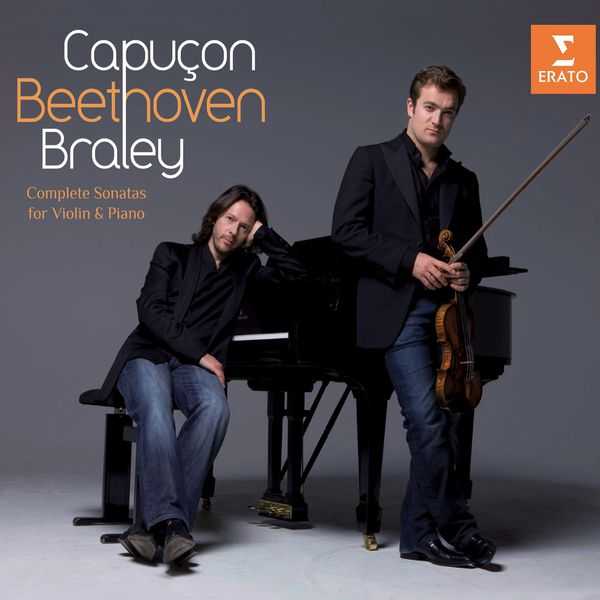
Composer: Ludwig van Beethoven
Performer: Renaud Capuçon, Frank Braley
Number of Discs: 3
Format: FLAC (tracks)
Label: Erato
Catalogue: 6420010
Release: 2010
Size: 922 MB
Recovery: +3%
Scan: yes
CD 01
Violin Sonata No. 1 in D Major, Op. 12 No. 1
01. I. Allegro con brio
02. II. (a) Tema con variazioni. Andante con moto
03. II. (b) Variation I
04. II. (c) Variation II
05. II. (d) Variation III
06. II. (e) Variation IV
07. III. Rondo. Allegro
Violin Sonata No. 2 in A Major, Op. 12 No. 2
08. I. Allegro vivace
09. II. Andante, più tosto allegretto
10. III. Allegro piacevole
Violin Sonata No. 3 in E-Flat Major, Op. 12 No. 3
11. I. Allegro con spirito
12. II. Adagio con molt’espressione
13. III. Rondo. Allegro molto
Violin Sonata No. 4 in A Minor, Op. 23
14. I. Presto
15. II. Andante scherzoso
16. III. Allegro molto
CD 02
Violin Sonata No. 5 in F Major, Op. 24 “Spring”
01. I. Allegro
02. II. Adagio molto espressivo
03. III. Scherzo. Allegro molto
04. IV. Rondo. Allegro ma non troppo
Violin Sonata No. 8 in G Major, Op. 30 No. 3
05. I. Allegro assai
06. II. Tempo di minuetto, ma molto moderato e grazioso
07. III. Allegro vivace
Violin Sonata No. 9 in A Major, Op. 47 “Kreutzer”
08. I. Adagio sostenuto – Presto
09. II. (a) Andante con Variazioni. Andante
10. II. (b) Variation I
11. II. (c) Variation II
12. II. (d) Variation III
13. II. (e) Variation IV
14. III. Finale. PrestoFrank Braley08:22
CD 03
Violin Sonata No. 6 in A Major, Op. 30 No. 1
01. I. Allegro
02. II. Adagio molto espressivo
03. III. (a) Allegretto con variazioni. Allegretto
04. III. (b) Variation I
05. III. (c) Variation II
06. III. (d) Variation III
07. III. (e) Variation IV
08. III. (f) Variation V
09. III. (g) Variation VI
Violin Sonata No. 7 in C Minor, Op. 30 No. 2
10. I. Allegro con brio
11. II. Adagio cantabile
12. III. Scherzo. Allegro
13. IV. Finale. Allegro
Violin Sonata No. 10 in G Major, Op. 96
14. I. Allegro moderato
15. II. Adagio espressivo
16. III. Scherzo. Allegro
17. IV. Poco allegretto
Renaud Capuçon and Frank Braley have devoted much of their 2009-10 concert schedule to Beethoven’s complete sonatas for violin and piano. “These sonatas are full of memories for me,” says Capuçon. “The ‘Spring’ Sonata was the first piece of Beethoven I played, when I was ten years old. His music is a rite of passage for every violinist.”
This complete recording of Beethoven’s sonatas for violin and piano grows from a marathon performance project that Renaud Capuçon and Frank Braley launched in their native France in Summer 2009: some 50 concerts around Europe, all devoted to the Beethoven sonatas.
The BBC Music website has observed that: “Capuçon’s style, perhaps because of his regular chamber work, is natural, understated and perceptive; the sound of a musician happily relaxed in his skin and not feeling the need to prove any virtuosic credentials.” Indeed, chamber music has always played a central role in his activities, and – beyond his cellist brother Gauthier – his regular partners include pianists Frank Braley and Nicholas Angelich, while his list of colleagues also includes such names as Martha Argerich, Daniel Barenboim, Hélène Grimaud, André Watts, Yefim Bronfman, Myung-Whun Chung, Stephen Kovacevich, Jean-Yves Thibaudet, Vadim Repin, Katia and Marielle Labèque, Yuri Bashmet and Truls Mørk.
“The complete Beethoven is a major project for the next two years,” explained Capuçon to the newspaper Sud-Ouest in summer 2009. “We hadn’t yet performed the Beethoven sonatas in France and we will be taking them on a major European tour. They are a real marathon of three-and-a-half hours of music. We perform the ten sonatas in chronological order so that we can follow the composer’s evolution.
“These sonatas are full of memories for me. The ‘Spring’ Sonata was the first piece of Beethoven I played, when I was ten years old. His music is a rite of passage for every violinist. I wanted to perform the complete cycle before thinking about the Bach sonatas, which are the Everest of the repertoire.
“Beethoven gives you no place to hide in these sonatas. You have to find their spinal column, create a structure – and sing. Without wishing to appear pretentious, I’ve always felt at ease with Beethoven, more than with Schubert or Mozart. But it is for the public to judge.”
According to another French newspaper, La Provence, Capuçon and Braley “won over the public in triumphant fashion” at the festival of La Roque d’Anthéron with interpretations of Beethoven that were “fluid, precise, full of integrity … emphasising both the sweetness and energy of Beethoven … The two instruments established a delicious dialogue.”
Renaud Capuçon’s Virgin Classics recording of the Beethoven Violin Concerto, released in 2009, prompted the BBC Music Magazine to state that he “approaches the Beethoven Concerto very much like the great virtuosos of the past through emphasising the work’s lyrical and expressive qualities”. He and Braley have frequently performed together as a duo and their previous recordings of chamber music for Virgin Classics embrace Schubert (the ‘Trout’ Quintet and the Trios opp 99 & 100) and Ravel (the Piano Trio and Violin Sonata).
Among the many genres Beethoven used to build on his reputation upon his arrival in Vienna, the violin sonatas allowed him not only to demonstrate his own prowess on the keyboard, but also played to the increasing popularity of chamber works that might be attempted by sophisticated amateurs. Following Mozart’s trend of liberating the violin from a mere secondary role, Beethoven continued to bring about the equality of both instruments in all of his duo sonatas. Performing these 10 sonatas is the splendid duo of violinist Renaud Capuçon and pianist Frank Braley. The recordings take place in la Chaux de Fonds concert hall in Switzerland, a venue that offers listeners an exceptionally wonderful, intimate sound quality even on a CD. Capuçon and Braley clearly share a unified, singular vision for these predominantly youthful sonatas. They shed new light and freshness on the well-known sonatas like the Op. 24 “Spring” and Op. 47 “Kreutzer” sonatas, as well as treating the less-often performed sonatas with the same level of intrigue and vivaciousness. Capuçon’s playing is sweet and warm, even in the higher registers of his instrument. Braley’s touch is especially nuanced, ranging from forceful to delicate; his limited use of the pedal produces an especially clear, clean articulation, particularly in the piano’s lower range. Suitable as a first recording of these wonderful sonatas or as an addition to an extensive collection, this three-disc set is broadly appealing.



